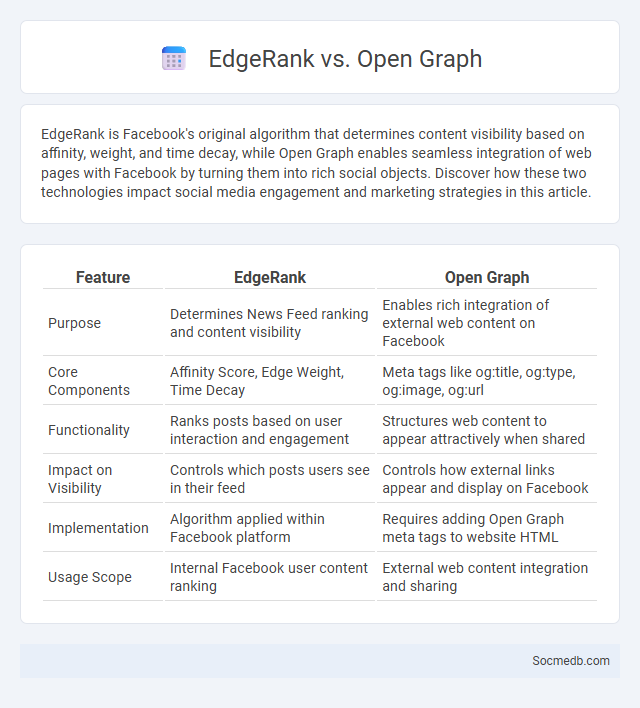
Photo illustration: EdgeRank vs Open Graph
EdgeRank is Facebook's original algorithm that determines content visibility based on affinity, weight, and time decay, while Open Graph enables seamless integration of web pages with Facebook by turning them into rich social objects. Discover how these two technologies impact social media engagement and marketing strategies in this article.
Table of Comparison
| Feature | EdgeRank | Open Graph |
|---|---|---|
| Purpose | Determines News Feed ranking and content visibility | Enables rich integration of external web content on Facebook |
| Core Components | Affinity Score, Edge Weight, Time Decay | Meta tags like og:title, og:type, og:image, og:url |
| Functionality | Ranks posts based on user interaction and engagement | Structures web content to appear attractively when shared |
| Impact on Visibility | Controls which posts users see in their feed | Controls how external links appear and display on Facebook |
| Implementation | Algorithm applied within Facebook platform | Requires adding Open Graph meta tags to website HTML |
| Usage Scope | Internal Facebook user content ranking | External web content integration and sharing |
Introduction to Facebook Algorithms: EdgeRank and Open Graph
Facebook's EdgeRank algorithm determines the visibility of posts on Your News Feed by evaluating factors such as affinity, weight, and time decay to prioritize content most relevant to You. The Open Graph protocol enables websites and apps to integrate with Facebook by sharing rich metadata, enhancing how content appears and is shared across the platform. Understanding both EdgeRank and Open Graph is essential for optimizing social media strategies to increase engagement and reach.
What is EdgeRank?
EdgeRank is a proprietary algorithm used by Facebook to determine the relevance and ranking of posts in a user's news feed. It analyzes factors such as affinity (your relationship with the content creator), edge weight (type of interaction like comments or likes), and time decay (recency of the post) to prioritize which updates you see. Understanding EdgeRank can help optimize your social media strategy by increasing the visibility of your posts to your target audience.
Evolution of EdgeRank: Past and Present
EdgeRank, Facebook's initial algorithm for curating the News Feed, relied heavily on three key factors: affinity, weight, and time decay to prioritize relevant content for users. Over time, EdgeRank evolved into a more complex machine learning system incorporating hundreds of signals, such as user interactions, content popularity, and post type, enabling personalized and dynamic content delivery. The present algorithm emphasizes meaningful interactions and context, optimizing user engagement by predicting which posts will generate valuable social connections and prolonged platform activity.
Understanding Open Graph: Definition and Features
Open Graph is a protocol developed by Facebook that enables web pages to become rich objects in social media by allowing control over how content is displayed when shared. Key features include customizable titles, descriptions, images, and URLs, enhancing content visibility and engagement across platforms like Facebook, LinkedIn, and Twitter. Implementing Open Graph tags improves click-through rates and ensures consistent branding by providing precise metadata for social sharing.
EdgeRank vs Open Graph: Key Differences
EdgeRank and Open Graph are fundamental social media algorithms with distinct functionalities; EdgeRank primarily governs Facebook's News Feed ranking by evaluating user engagement, affinity, and content type to prioritize posts, while Open Graph is a protocol that allows websites to integrate their content with Facebook by enabling rich sharing features like custom titles, images, and metadata. EdgeRank's algorithmic scoring affects content visibility and user interaction frequency directly within the platform, whereas Open Graph enhances content presentation and sharing outside of Facebook, improving link previews and social interactions across the web. Understanding these key differences helps marketers optimize content distribution strategies, balancing organic reach through EdgeRank's factors and enriched content display via Open Graph integration.
How EdgeRank Impacts Facebook News Feed
EdgeRank significantly impacts your Facebook News Feed by determining which posts appear based on affinity, weight, and time decay algorithms. The algorithm prioritizes content from friends, pages, or groups you interact with most, ensuring relevance and engagement. Understanding EdgeRank allows you to optimize your posts for higher visibility and better reach on Facebook.
Role of Open Graph in Facebook Content Sharing
The Open Graph protocol enables Facebook to extract rich metadata from web pages, enhancing how shared content appears in the News Feed with images, titles, and descriptions. This structured data improves user engagement by making posts more visually appealing and contextually relevant. Implementing Open Graph tags is crucial for maximizing visibility and click-through rates on Facebook.
Optimizing Content for EdgeRank
Optimizing content for EdgeRank requires focusing on user engagement metrics such as likes, comments, and shares to increase visibility in Facebook's News Feed algorithm. High-quality, relevant content paired with consistent posting schedules enhances affinity scores between users and pages, boosting reach. Incorporating multimedia elements like images and videos further elevates EdgeRank by capturing audience attention and encouraging interaction.
Leveraging Open Graph for Maximum Visibility
Leveraging Open Graph tags enables your social media content to display rich previews, including images, titles, and descriptions that enhance click-through rates. Properly implementing Open Graph metadata ensures that your posts appear consistently and attractively across platforms like Facebook and LinkedIn, maximizing your content's visibility. Optimizing these tags can significantly boost engagement by delivering clear, compelling information tailored for social media sharing.
Future Trends: Beyond EdgeRank and Open Graph
Social media is rapidly evolving with future trends focusing on AI-driven personalization and immersive experiences like augmented reality (AR) and virtual reality (VR). Innovations beyond EdgeRank algorithms and Open Graph protocols prioritize contextual content delivery, leveraging machine learning to enhance user engagement and predictive analytics. Platforms are integrating decentralized social networks and blockchain technologies to increase data privacy and user ownership, reshaping the digital interaction landscape.
 socmedb.com
socmedb.com